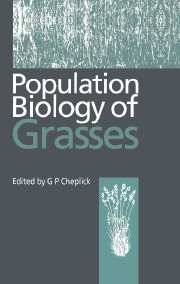Book contents
- Frontmatter
- Contents
- Contributors
- Preface
- Darwin revisited: approaches to the ecological study of grasses
- Part one Population variation and life history patterns
- 1 Allozyme diversity in the grasses
- 2 Ecology of seed dormancy and germination in grasses
- 3 Seed dispersal and seedling establishment in grass populations
- 4 Clonal biology of caespitose grasses
- 5 Ecological aspects of sex expression in grasses
- 6 Interspecific variation in plasticity of grasses in response to nitrogen supply
- 7 Population biology of intraspecific polyploidy in grasses
- Part two Ecological interactions
- Part three Population biology of specific groups
- Index
7 - Population biology of intraspecific polyploidy in grasses
Published online by Cambridge University Press: 14 September 2009
- Frontmatter
- Contents
- Contributors
- Preface
- Darwin revisited: approaches to the ecological study of grasses
- Part one Population variation and life history patterns
- 1 Allozyme diversity in the grasses
- 2 Ecology of seed dormancy and germination in grasses
- 3 Seed dispersal and seedling establishment in grass populations
- 4 Clonal biology of caespitose grasses
- 5 Ecological aspects of sex expression in grasses
- 6 Interspecific variation in plasticity of grasses in response to nitrogen supply
- 7 Population biology of intraspecific polyploidy in grasses
- Part two Ecological interactions
- Part three Population biology of specific groups
- Index
Summary
Polyploidy is the duplication of an entire nuclear genome, whether diploid or higher level (Stebbins, 1971; Thompson & Lumaret, 1992) and a frequent occurrence in plants. Stebbins (1971) estimated that 30–35% of flowering plant species are polyploid, and that many more had a polyploid event in their evolutionary history, including all members of such important families as the Magnoliaceae, Salicaceae, and Ericaceae. Goldblatt (1980) estimated 55%, but probably up to 75%, of monocotyledons had at least one polyploid event in their history, using the criterion that if the species has a base number higher than n= 13 it is derived from a polyploid. Using the same criterion, Grant (1981) estimated that 52% of angiosperms, 49% of dicotyledon species and 60% of monocotyledons are polyploid. Masterson (1994) supports high frequencies of ancestral polyploidy using fossil evidence. Clearly, polyploids have been fixed in many lineages.
Within many genera of higher plants, individual species often have different, but uniform, ploidy levels (e.g. Draba, Brassicaceae, Brockman & Elven, 1992), the grasses being no exception, e.g. Bromus, Elymus (Seberg & von Bothmer, 1991; Ainouche, Misset & Huon, 1995). Intrageneric polyploid series provide another indicator of frequent polyploid events. For example, of a miscellaneous collection of 87 grass genera for which I had chromosome numbers for two or more species, 65 (75%) formed a polyploidy series in relation to other members of the genus (Table 7.1).
Stebbins (1947) distinguished the forms of polyploidy based on whether the duplicated genomes are derived from one species (autopolyploidy) or two (allopolyploidy) or both (segmental allopolyploidy).
- Type
- Chapter
- Information
- Population Biology of Grasses , pp. 183 - 206Publisher: Cambridge University PressPrint publication year: 1998
- 13
- Cited by

